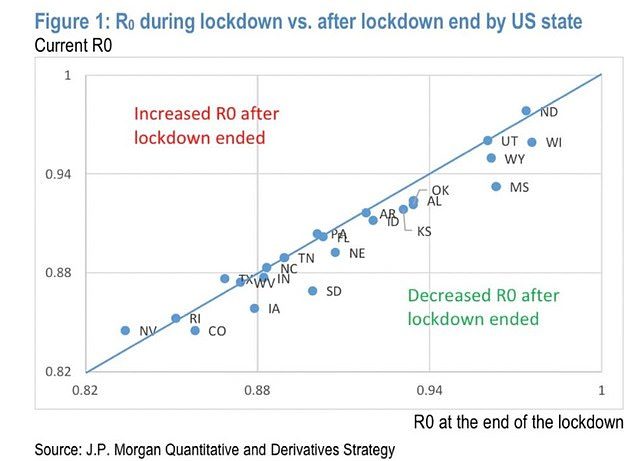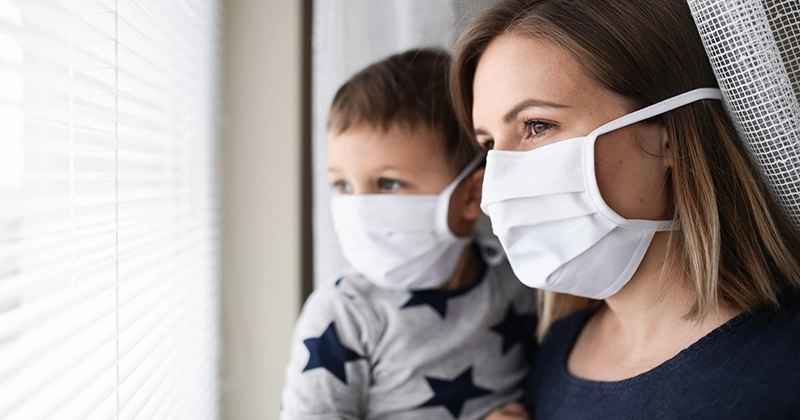Faldende infektionsrater, siden lockdowns blev ophævet antyder, at virussen "sandsynligvis har sin egen dynamik", som "ikke er relateret til ofte inkonsekvente nedluknings-foranstaltninger", siger en rapport udgivet af giganten for finansielle tjenester.
Danmark er blandt de lande, der har set sin R-sats fortsætte med at falde, efter at skoler og indkøbscentre blev genåbnet, mens Tysklands rate for det meste forblev under 1,0, efter at lempningen blev indført.
Kommentar: Delvist oversat af Sott.net fra Lockdowns failed to alter the course of pandemic and are now destroying millions of livelihoods worldwide, JP Morgan study claims
The report also shows many US states including Alabama, Wisconsin and Colorado enjoying lower R rates after lockdown measures were lifted.
Author Marko Kolanovic, a trained physicist and a strategist for JP Morgan, said governments had been spooked by 'flawed scientific papers' into imposing lockdowns which were 'inefficient or late' and had little effect.
'Unlike rigorous testing of new drugs, lockdowns were administered with little consideration that they might not only cause economic devastation but potentially more deaths than Covid-19 itself,' he claimed.

Infection rates have continued to decline even once a lag period for new infections to become visible is factored in, the report says.
A second graph shows a similar effect in the US, showing that many states saw a lower rate of transmission (R) after full-scale lockdowns were ended.
They included Colorado, Iowa, Alabama, Wyoming, Wisconsin and Mississippi, according to the chart, although not all states are included.
Nevada and North Dakota are among the exceptions which appear to have had a higher rate of transmission since normal life began to resume.
The R rate shows how many people each virus patient typically infects, and some countries regard a rate below 1.0 as a key indicator that the epidemic is in retreat.
'While we often hear that lockdowns are driven by scientific models, and that there is an exact relationship between the level of economic activity and the spread of [the] virus - this is not supported by the data,' the report says.
'Indeed, virtually everywhere infection rates have declined after re-opening even after allowing for an appropriate measurement lag.
'This means that the pandemic and Covid-19 likely have [their] own dynamics unrelated to often inconsistent lockdown measures that were being implemented.'
Those dynamics may be influenced by increased hand-washing and even weather patterns but seemingly not by full-scale lockdowns, the report suggests.
'The fact that re-opening did not change the course of the pandemic is consistent with studies showing that initiation of full lockdowns did not alter the course of the pandemic either,' it says.
An Oxford University professor has previously suggested that the crisis in Britain began falling from its peak before Boris Johnson ordered a lockdown on March 23.
Professor Carl Heneghan said last month that the peak of new cases had come on April 8, suggesting a peak of infection three weeks earlier around March 18.
The JP Morgan analysis linked the decision to impose lockdowns to 'flawed scientific papers' predicting millions of deaths in the West.
'This on its own was odd, given that in China there were only several thousand deaths, and the mortality rate outside of Wuhan was very low,' it says.
'In the absence of conclusive data, these lockdowns were justified initially. Nonetheless, many of these efforts were inefficient or late.'
In some European countries, studies suggest that the measures 'did not produce any change in pandemic parameters' such as the R rate, the JP Morgan report says.
Kolanovic says that lockdowns had remained in place even as 'our knowledge of the virus and lack of effectiveness of total lockdowns evolved'.
'At the same time, millions of livelihoods were being destroyed by these lockdowns,' he writes.
Countries in lockdown are having to blow huge holes in their budgets to counter the economic standstill which is forcing millions of people into unemployment.
The report also cites 'worrying populism' as an obstacle to re-opening the economy, for example in the US where senators passed an anti-China measure this week.
It warns that economic activity in the US is 'now largely following partisan lines' as Republican and Democratic governors adopt different strategies for their states.
As well as casting doubt on the wisdom of imposing lockdowns in the first place, the report suggests that economies could now be re-opened more quickly.
Denmark is among the countries which has started re-opening its economy without seeing a new surge in virus cases.
Zoos, museums and cinemas have re-opened early in Denmark with many children now back at school after scientists said the R rate had continued to fall.
Germany has also been confident enough to scale back the lockdown after the R rate mostly stayed below 1.0 following an initial lifting of restrictions.
However, chancellor Angela Merkel has repeatedly urged caution and warned that a second wave of virus cases could leave hospitals overwhelmed.
Comment: Just like we warned of in the first 'wave', which turned out to be nothing but a wave of bored nurses making TikTok videos.
The UK government has similarly warned that some restrictions could be re-imposed if there is a 'sudden and concerning' rise in new cases.
The World Health Organisation has urged 'extreme vigilance' about lifing lockdowns, saying there is 'always the risk that the virus takes off again'.
WHO chief Tedros Adhanom Ghebreyesus said that some countries such as Germany and South Korea had systems in place to respond to a new surge.
However, Britain's efforts to set up a tracking and tracing system have been hampered by delays in rolling out the necessary app.
Tedros said that a 'comprehensive package of measures' is needed until a vaccine becomes available, which is likely to be many months away at least.
It is not yet fully clear how many people have been infected or to what extent they are now immune, but most people remain susceptible.
Some vaccine projects have already begun testing humans, including at Oxford University.
Up to 1,102 participants have been recruited across multiple study sites in Oxford, Southampton, London and Bristol, although results are not expected for weeks.
Imperial College London is also progressing with its vaccine candidate and will look to move into clinical trials by mid-June, with larger scale trials in October.
However, experts and politicians warn there is no guarantee that an effective vaccine will ever be developed.
Even if it is, there are concerns about how it will be distributed in large enough quantities to bring the pandemic to a standstill.





Kommentar: Despite the information given in the above article, they still end off by saying you need to remain afraid. The 'pandemic' was nothing but an overreaction to a fairly mundane virus. Yet in spite of the fact that this was blatantly obvious fairly early on, the authorities continued the sham lockdown while the population and economy suffered. One imagines the blowback is going to be epic.
See also: